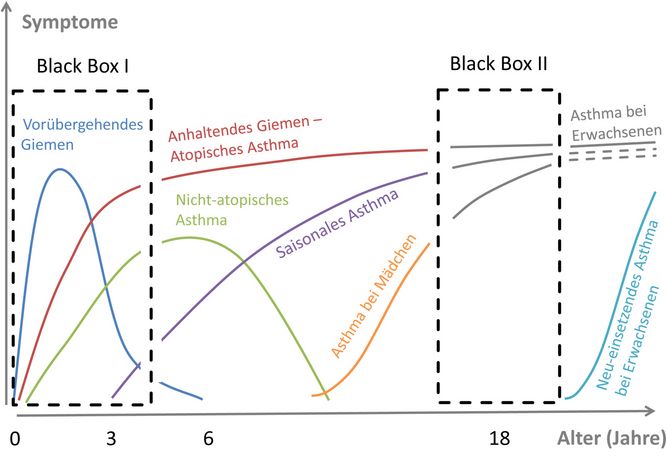What exactly is bronchial asthma?
This, that and probably something else! This could be a casual summary of the current scientific findings. Because even if the asthma symptoms are always similar (cough, shortness of breath, wheezing breath sounds) – the disease is anything but clearly defined in terms of causes and course: Whistling respiratory diseases or bronchial asthma are frequent chronic diseases in children and adolescents, but they do not give a uniform picture. Rather, we are dealing with a complex syndrome with different manifestations, degrees of severity and temporal progressions.
Asthma causes – different in every child?
About a quarter of all children up to three years of age suffer at least once from a disease that is accompanied by wheezing breathing. For most children, this is a one-time event. Others, however, suffer more frequently from obstructive bronchitis and some even develop asthma. Some of the children also suffer from allergies, others do not. In some children the disease disappears in the course of development, in others it persists beyond puberty.
So we do not assume that there is a uniform disease group,
but several asthma subgroups:
Is asthma curable – or what would the therapy be?
So far it is not possible to really cure asthma. However, it is possible to treat the symptoms very well with modern drugs.

The ALL AGE ASTHMA COHORT (ALLIANCE) of the German Center for Lung Research (DZL) aims to trace the complex interrelationships that underlie the different forms of asthma and other whistling respiratory diseases. The large-scale study has been running since 2011 with now more than 700 patients throughout Germany. The aim of the study is to identify biomarkers (signal transducers) that will make it possible in the future to identify the respective subtype of the disease as early as possible. This would also make it possible to tailor the treatment to each individual patient.
ALLIANCE - a strong alliance for new insights into asthma therapy

© Helmholtz München
At the DZL sites in Lübeck, Hannover and Munich, as well as in the affiliated centers in Marburg and Cologne, children aged from 6 months to 18 years of age are included, and in Großhansdorf adult patients are also included in the ALLIANCE study.
In Munich, in the CPC-M, the study visits are carried out with the participating patients in the Christiane Herzog Outpatient Clinic of the Dr. von Hauner Children's Hospital. For example, the ALLIANCE team measures children's lung function, takes blood samples, performs sweat tests or nasal swabs or measures exhaled air using an electronic nose, the "e-nose". After a first comprehensive basic examination, the patients come for a further visit every 12 months. The study participants from the control group (healthy) come only once.
Where do we stand – what do we know about the asthma subgroups?
Today we differentiate between two basic forms of asthma, allergic and non-allergic asthma. In allergic asthma, an excessive reaction of the immune system leads to chronic inflammation of the respiratory tract. Patients often suffer from other allergic symptoms, such as allergic rhinitis or conjunctivitis (inflammation of the conjunctiva of the eye). In some cases, the symptoms occur only at certain times of the year, e.g. in the case of an allergy to pollen. House dust mite allergy sufferers often have symptoms all year round. In the treatment of allergies, specific immunotherapy, hyposensitization, has been offered for several years. This also makes the therapy of a possible trigger for asthmatic complaints possible.
In non-allergic asthma many different factors play a role. Often, the disease occurs after a viral infection. This form has a lower risk of leading to a long-lasting chronic inflammation of the bronchi.
The ALLIANCE study focuses in particular on the deciphering of the different mechanisms of chronic respiratory inflammation and is a prerequisite for offering patients with asthma a more individualized therapy in the future.



